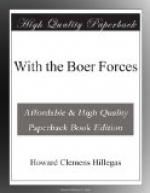When they were on hills the Boers were able to entrench themselves so thoroughly that the fire of several hundred heavy guns made hardly any impression on them, but as soon as they attempted to apply those tactics on level ground the results were most disastrous. At Colenso and Magersfontein the burghers remained in their trenches on the hills while thousands of shrapnel and other shells exploded above and around them, but very few men were injured, and when the British infantry advanced under cover of the shell fire the Boers merely remained in the trenches until the enemy had approached to within several hundred yards and then assailed them with rifle fire. Trenches always afforded perfect safety from shell fire, and on that account the Boers were able to cope so long and well with the British in the fighting along the Tugela and around Kimberley. The Boers generally remained quietly in their trenches and made no reply to the British cannon fire, however hot it was. The British generals several times mistook this silence as an indication that the Boers had evacuated the trenches, and sent forward bodies of infantry to occupy the positions. When the infantry reached the Boer zone of fire they usually met with a terrific Mauser fire that could not be stemmed, however gallant the attacks might have been. Hundreds of British soldiers lost their lives while going forward under shell fire to occupy a position which, it was presumed by the generals, was unoccupied by the Boers.
There were innumerable instances, also, of extraordinarily brave acts by individual burghers, but it was extremely difficult to hear of them owing to the Boers’ disinclination to discuss a battle in its details. No Boer ever referred to his exploits or those of his friends of his own volition, and then only in the most indefinite manner. He related the story of a battle in much the same manner he told of the tilling of his fields or the herding of his cattle, and when there was any part of it pertaining to his own actions he passed it over without comment. It seemed as if every one was fighting, not for his own glorification, but for the success of his country’s army, and consequently there was little hero-worship. Individual acts of bravery entitled the fortunate person to have his name mentioned in the Staats-Courant, the Government gazette, but hardly any attention was paid to the search for heroes, and only the names of a few men were even chronicled in the columns of that periodical. One of the bravest men in the Natal campaign was a young Pretoria burgher named Van Gas, who, in his youth, had an accident which made it necessary that his right arm should be amputated at the elbow. Later in life he was injured in one of the native wars and the upper arm was amputated, so that when he joined a commando he had only the left arm. It was an extraordinary spectacle to observe young Van Gaz holding his carbine between his knees while loading it with cartridges, and quite as strange to




